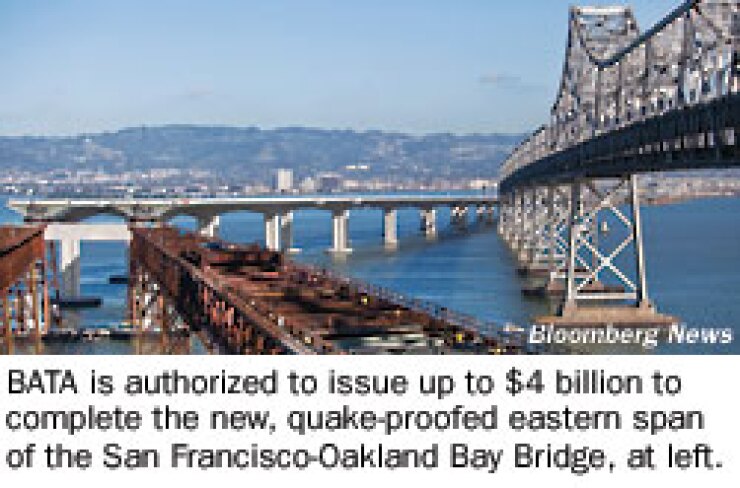

ALAMEDA, Calif. — California’s Bay Area Toll Authority will hit the market next month with a hefty Build America Bond deal.
The taxable offering — carrying a new subordinate lien on toll revenues from seven state-owned bridges in the San Francisco region — is currently penciled in at about $1.5 billion, though that can easily be upsized if demand is there, said BATA chief financial officer Brian Mayhew.
He has authorization to issue up to $4 billion in toll revenue bonds through the end of the year. Barring any unpleasant surprises, that’s an amount that should be sufficient to finance the remaining elements of the authority’s massive earthquake-retrofit program, centered on the replacement of the east span of the San Francisco-Oakland Bay Bridge.
A large transaction now makes sense, given the interest rate environment and the dynamics of the taxable bond market, according to Mayhew.
“There is a reward for size in the taxable world because size equates to liquidity,” he said.
The $4 billion bond authorization covers financings that were originally planned between 2011 and 2014, Mayhew said.
At current rates, after factoring in the 35% federal interest subsidy on Build America Bonds, Mayhew said BATA is able to price 40-year debt at net yields comparable to what it was getting with synthetic fixed-rate transactions, without the bond insurance, liquidity, and swap complications that ultimately led so many of those deals to unravel.
“It certainly takes an awful lot of the financial risk off the plate for the next three years,” he said. “It takes interest rate risk off the table; it takes market access risk off the table.”
Since it’s all but certain that any federal BAB renewal will come with a lower subsidy, it makes even more sense to act before the current program expires at year end, Mayhew added.
“Thank God the federal government came up with this program,” he said. “It’s kept every major project — existing and new — going.”
Bank of America Merrill Lynch, Citi, and JPMorgan will be the senior managers, Mayhew said.
“If everything goes well, we’ll probably be dealing with the investors over the next couple weeks and pricing in the second or third week of June,” he said.
It’s not BATA’s first experience with BABs — the authority sold $1.3 billion in senior toll revenue bonds late last year.
BABs were created as part of the 2009 federal economic stimulus bill.
The new subordinate lien will allow the authority to issue more debt while strengthening the senior lien, Mayhew said.
“The commercial world doesn’t give you such a penalty for subordinate,” he said.
Standard & Poor’s and Moody’s Investors Service this week assigned A-plus and A1 ratings, respectively, to the new bonds while affirming their AA and Aa3 ratings on BATA’s senior toll revenue bonds.
Both agencies noted as a credit positive BATA’s ability — and willingness — to raise tolls, as it will do July 1. That’s when tolls for automobiles on most of its bridges will increase 25%, while a new congestion-based variable toll structure will be implemented on its busiest span, the San Francisco-Oakland Bay Bridge, where rush-hour auto tolls (collected one way only) will reach $6, up from the current $4.
“The ratings we have are very strong ratings and they will work in the commercial world,” Mayhew said.
The authority is likely to be back in the market in the fall to continue working on its authorization, he said.
That deal is likely to involve tax-exempt bonds in whole or in part, as traditional municipal bonds, with their call provisions and more flexible maturities, should help BATA shape its overall debt service schedule.





